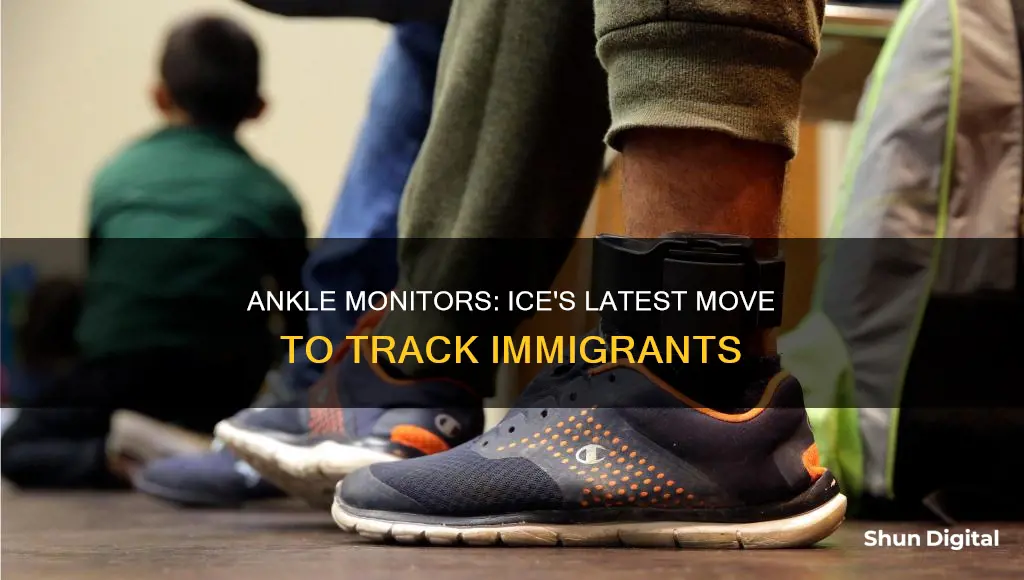
Ankle monitors are a form of surveillance used by Immigration and Customs Enforcement (ICE) to track migrants. They are an alternative to detention, allowing migrants to be monitored while they await their court hearings or immigration proceedings. While they are considered more cost-effective and humane than detention, ankle monitors have been criticised for their negative physical and psychological impacts on those who wear them, including pain, discomfort, anxiety, and social stigma.
| Characteristics | Values |
|---|---|
| Purpose | To track migrants' locations and ensure compliance with release conditions, court hearings, and final orders of removal |
| Target Group | Immigrants, asylum seekers, and parolees |
| Technology | GPS tracking, radio frequency signals, audio messages |
| Physical Impact | Inflammation, severe cramps, bleeding, sores, numbness, bruising, skin eruptions, hair loss, electric shocks |
| Psychological Impact | Anxiety, sleeplessness, depression, social isolation, stress, fear, trauma |
| Social Impact | Stigma, embarrassment, discrimination, limitations on employment opportunities |
| Privacy Concerns | Lack of transparency about data usage, potential for data sharing or selling |
What You'll Learn

To ensure migrants awaiting asylum hearings are tracked
Alternatives to Detention (ATD) programs have emerged as a common-sense alternative to family detention as federal authorities look for solutions to manage the influx of immigrants from Central America. Immigration and Customs Enforcement (ICE) officials have found electronic monitoring devices, or ankle monitors, to be both economical and effective. Ankle monitors are appropriate for immigrants who are neither a flight nor safety risk, freeing up detention space for others.
In July 2018, over 38,000 immigrants were fitted with ankle monitors, representing 45% of all individuals in the Intensive Supervision of Appearance Program (ISAP), ICE's primary ATD program. ATD programs are more cost-effective than detention. ICE spends an average of more than $200 per day to detain someone, and this number increases when detaining families. In contrast, low-cost ATD programs like community supervision or electronic monitoring programs can cost as little as $4.50 per day.
ATDs are also effective at ensuring immigrants show up to immigration court. In 2012, only five percent of those in ICE's leading ATD program absconded, a much smaller number than those who ultimately received asylum or were deported. However, ankle monitors have been reported to cause inflammation, severe cramps, bleeding, sores, and numbness around the foot and leg, as well as damaging psychological effects.
The use of ankle monitors as a form of surveillance also has a significant physical and psychological toll on asylum seekers. Boston University immigrant rights expert Sarah Sherman-Stokes refers to this method of monitoring as "digital cages," arguing that it is not a more humane alternative to physical detention centers. Asylum seekers are already in legal limbo, and the constant supervision and surveillance of ankle monitors only add to their anxiety and feelings of being controlled.
The stigma associated with ankle monitors also limits employment opportunities for immigrants. Individuals wearing ankle monitors have expressed feelings of being imprisoned, and recent immigrants from Central American countries refer to the monitors as "grilletes," which means "shackles" in Spanish. The identification of ankle monitors with criminality makes electronically monitored employees less appealing to employers, even when the perspective employee has no criminal record and is authorized to work.
In addition, ICE rules related to electronic monitoring programs place further burdens on prospective workers, including unannounced home visits, nightly curfews, and geographical limits, all of which significantly hinder immigrants' ability to maintain a steady job. For example, one asylum seeker who worked at a construction site was fired after a pre-programmed message on his ankle monitor went off in front of his boss.
Blind Spot Monitor: Standard or Optional for Mercedes?
You may want to see also

To reduce costs, as it is cheaper than detention
Alternatives to detention (ATDs) have gained attention as a more cost-effective, humane alternative to family detention. Immigration and Customs Enforcement (ICE) has found electronic monitoring devices, such as ankle monitors, to be both economical and effective.
ICE spends over $200 per day to detain someone in immigration detention, with families costing even more at $319 per person per day. In contrast, low-cost ATD programs like community supervision or electronic monitoring can cost as little as $4.50 per day.
ATDs are also effective at ensuring immigrants show up for their court appearances. In July 2018, over 38,000 immigrants were fitted with ankle monitors, representing 45% of all individuals in ICE's primary ATD program, the Intensive Supervision of Appearance Program (ISAP). ATD programs have a high success rate, with over 90% of immigrants attending their court appearances.
By using ATDs, ICE can reserve detention space for those who are a flight or safety risk. This frees up resources and allows ICE to focus on those who are subject to mandatory detention.
While ATDs offer significant cost savings and are more humane than detention, they do come with their own set of concerns. Ankle monitors have been reported to cause physical issues such as inflammation, cramps, bleeding, sores, and numbness. They also carry a significant social stigma, with individuals wearing them expressing feelings of being imprisoned and facing difficulties in finding employment due to the negative perception associated with ankle monitors.
Additionally, there are privacy concerns with the data collected by ICE through electronic monitoring. Little information is available on how ICE uses the data, who has access to it, and how long it is stored.
Despite these concerns, ATDs, including ankle monitors, offer a more cost-effective and humane alternative to detention. By reducing costs, ICE can manage the influx of immigrants more effectively while ensuring high compliance rates with court appearances.
Connecting a Laptop to a Monitor: Easy Steps to Success
You may want to see also

To free up detention space for those who pose a flight or safety risk
Alternatives to detention (ATDs) such as ankle monitors are used by Immigration and Customs Enforcement (ICE) to free up detention space for those who pose a flight or safety risk. In 2018, the practice of separating immigrant families at the border caused public outrage, and with the Flores Settlement Agreement preventing the government from holding detained families with young children indefinitely, ATDs emerged as a common-sense alternative to family detention.
ATDs are more cost-effective than detention. ICE spends more than $200 per day to detain someone in immigration detention, and this number rises when detaining families. In contrast, low-cost ATD programs like community supervision or electronic monitoring can cost as little as $4.50 per day. In 2018, Congress funded ATDs at $180 million, an increase of $66 million from 2017, demonstrating its interest in funding these programs.
ATDs are also effective at ensuring immigrants show up for their immigration court proceedings. In July 2018, over 38,000 immigrants were fitted with ankle monitors, representing 45% of all individuals in ICE's primary ATD program, the Intensive Supervision of Appearance Program (ISAP). ATDs have proven to be highly effective in ensuring immigration court attendance, with many programs exceeding 90% success rates.
However, it is important to note that the use of electronic monitoring devices, such as ankle monitors, has negative impacts on those wearing them. Ankle monitors impose significant restraints on the wearer's freedom of movement and are equipped with GPS capabilities that monitor an individual's location and movement in real time. They also require frequent charging, which can be inconvenient and restrict the wearer's mobility. Additionally, there have been reports of physical and psychological impacts, including inflammation, severe cramps, bleeding, sores, and numbness around the foot and leg, as well as feelings of embarrassment and social stigma.
Despite these concerns, the use of ATDs, including ankle monitors, is likely to continue as a cost-effective and relatively successful alternative to detention for immigrants who do not pose a flight or safety risk, thereby freeing up resources for those who do.
Unlocking Monitor Potential: Why is My ASUS Stuck at 60Hz?
You may want to see also

To ensure compliance with release conditions and court hearings
Ankle monitors are often used as a condition of release for individuals who are awaiting trial or have been granted parole. They are employed as a means of ensuring compliance with specific court-ordered conditions and can help facilitate the timely appearance of individuals at court hearings.
The use of ankle monitors allows authorities to track the whereabouts of individuals and ensure they adhere to any geographical restrictions imposed as part of their release conditions. For example, a person may be prohibited from entering certain neighbourhoods or areas known for criminal activity. The monitor provides a way to enforce this restriction and alert authorities if the individual enters a prohibited zone.
Additionally, ankle monitors can be used to enforce curfews, another common condition of release. By setting specific times during which the individual must remain at an approved residence, authorities can ensure compliance with curfew requirements. This also reduces the likelihood of the individual engaging in criminal activity under the cover of darkness.
For those with a history of substance abuse or addiction, ankle monitors can be employed to enforce mandatory attendance at rehabilitation programmes or counselling sessions. The device ensures the individual attends the required appointments, serving as a means of supporting their recovery and reducing the risk of reoffending.
In cases where the individual is required to maintain employment as a condition of their release, ankle monitors can provide verification of their adherence to this condition. The device can confirm their presence at a place of work during specified hours, demonstrating compliance with court orders. This use of ankle monitors can also support the individual's reintegration into society by encouraging a stable routine.
Expanding Your View: Four Monitors with the Asus G74SX-DH72
You may want to see also

To reduce the number of people in immigration detention
Alternatives to detention (ATDs) have gained increasing attention as a way to reduce the number of people in immigration detention. In 2018, the practice of separating immigrant families at the border came to the public’s attention, and with the Flores Settlement Agreement preventing the government from holding detained families with young children indefinitely, ATDs have emerged as a common-sense alternative to family detention.
ATDs are also supported by a significant cross-section of immigration, criminal justice, and civil rights organizations who believe they are cheap, effective, and humane. Electronic monitoring devices, or ankle monitors, are increasingly being used as ATDs since Immigration and Customs Enforcement (ICE) officials have found them to be both economical and effective.
In July 2018, over 38,000 immigrants were fitted with ankle monitors, representing 45% of all individuals in the Intensive Supervision of Appearance Program (ISAP), ICE’s primary ATD program. ATDs are more cost-effective than detention. ICE spends an average of more than $200 each day to detain someone in immigration detention, and when detaining families, this number increases to $319 per person per day. In contrast, low-cost ATD programs like community supervision or electronic monitoring programs can cost as little as $4.50 per day.
ATDs are also effective at ensuring immigrants show up to immigration court. In 2014, a Government Accountability Office report found that 95% of immigrants on “full-service” alternatives to detention appear for their final hearings. ATDs have proven to be highly effective in ensuring immigration court attendance, with many programs exceeding 90% success rates.
While some argue that immigrants might be able to cut off their ankle monitors or flee, data shows that only 5% of those in ICE’s leading ATD program in 2012 absconded, a much smaller number than those who ultimately received asylum or were deported.
However, ankle monitors have been reported to have negative impacts on those wearing them. They impose significant restraints on the wearer’s freedom of motion, and have been reported to cause inflammation, severe cramps, bleeding, sores, and numbness around the foot and leg, as well as damaging psychological effects.
The Intensive Supervision Appearance Program (ISAP) is a way for ICE to monitor undocumented or unnaturalized people without placing them in a detention facility. ISAP has flourished under President Biden, who has more than doubled the number of participants since December 2020, putting the current total at almost 200,000 people. For ICE, the program offers considerable cost savings compared to detention.
Clinton's Ankle Monitor: Fact or Fiction?
You may want to see also
Frequently asked questions
Immigration and Customs Enforcement (ICE) uses ankle monitors as an alternative to detention for immigrants who are awaiting court proceedings. Ankle monitors are deemed to be more cost-effective and humane than traditional detention methods.
There are several concerns associated with the use of ankle monitors by ICE. Firstly, there have been reports of physical pain, discomfort, and in some cases, electric shocks caused by the devices. Secondly, the stigma associated with wearing an ankle monitor can lead to social isolation, embarrassment, and limited employment opportunities for immigrants. Additionally, there are concerns about the privacy implications of the data collected by these monitoring devices and how it may be used by ICE or other entities.
ICE's Alternatives to Detention (ATD) program includes various approaches such as electronic monitoring, case management, parole/bond, and check-ins. One alternative to ankle monitors is the use of smartphone apps, such as SmartLINK, which utilizes facial recognition and location monitoring instead of a physical device.







